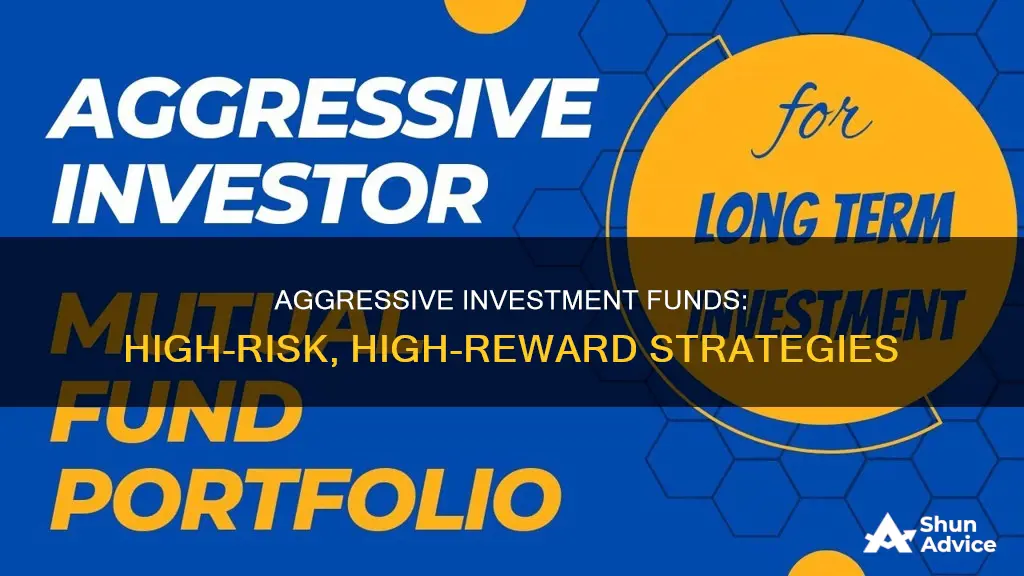
An aggressive investment fund is a high-risk, high-reward approach to investing. This strategy is typically used by younger investors or those with a high-risk tolerance. Aggressive investment funds focus on capital appreciation rather than capital preservation or income generation. These funds are actively managed and aim to achieve above-average returns by investing in companies with high growth potential, including newer companies and those in hot sectors of the economy. While they offer the potential for significant gains, they also carry a higher-than-average risk of losing money.

High-risk, high-reward
An aggressive investment fund is a high-risk, high-reward approach to investing. This strategy is suitable for younger investors or those with a higher risk tolerance, as it focuses on maximising returns by taking on more risk. The primary objective of an aggressive investment strategy is capital appreciation, rather than income or safety of principal.
Aggressive investment funds typically have a substantial weighting in stocks, with little to no allocation to bonds or cash. This means that investors in these funds are seeking capital gains by investing in the shares of growth companies. These companies often demonstrate high growth potential and are usually newer companies in hot sectors of the economy.
For example, an aggressive growth fund might aim for a 20% return one year, but this could result in an 8% loss the next year. Due to this volatility, these funds are generally recommended for investors who can withstand some down years in exchange for the possibility of large returns over time.
Aggressive investment funds are actively managed to achieve above-average returns when markets are rising. They are expected to outperform standard growth funds by investing heavily in companies with aggressive growth prospects.
An example of an aggressive allocation would be an 80/20 portfolio, which allocates 80% of its wealth to equities and 20% to bonds. This is in contrast to a more conservative 60/40 portfolio.
Money Market Funds: Investing in Corporate Bonds
You may want to see also

Capital appreciation
Aggressive investment strategies typically emphasize capital appreciation as a primary investment objective. These strategies involve taking on a relatively higher degree of risk to maximize returns. They are generally suitable for young adults with smaller portfolio sizes and a high tolerance for risk. Aggressive growth funds, also known as capital appreciation funds, invest in companies with high growth potential to achieve above-average market returns. These funds are actively managed and carry greater risk, possibly resulting in higher volatility and underperformance in down markets.
Overall, capital appreciation is a key aspect of aggressive investment strategies, where the focus is on maximizing returns by investing in high-growth and value stocks, despite the increased risk involved.
Monthly Mutual Fund Payments: A Smart Investment Strategy
You may want to see also

Allocation
Aggressive investment funds are a type of mutual fund that seeks to maximise returns by taking on a higher degree of risk. These funds are typically geared towards younger investors with a higher risk tolerance and a longer time horizon, allowing them to ride out market fluctuations.
Aggressive allocation funds, in particular, aim to provide both income and capital appreciation by investing in multiple asset classes, including stocks, bonds, and cash. These portfolios are heavily weighted towards stocks, with equity exposures of over 85%. They also allocate a significant portion, at least 10%, to foreign company equities.
- Meeder Dynamic Allocation Fund: Seeks long-term capital appreciation by investing in a diverse group of mutual funds.
- JPMorgan Investor Growth Fund: Focuses on achieving long-term capital appreciation by investing in a range of mutual funds.
- TIAA-CREF Lifestyle Aggressive Growth Fund: Aims for long-term growth of capital as a "fund of funds" investing in institutional-class shares.
- Franklin Mutual Shares Fund: Prioritises capital appreciation, with income as a secondary goal, by investing in equity securities.
- North Square Multi-Strategy Fund: Seeks capital appreciation as a "fund of funds" investing primarily in other funds.
- Gabelli Focused Growth and Income Fund: Pursues a high level of capital appreciation by investing in a concentrated portfolio of securities.
- E-Valuator Aggressive Growth Fund: Targets growth of principal within a specified asset allocation range by investing in securities of unaffiliated investment companies.
These funds offer a dynamic approach to investing, balancing the pursuit of capital appreciation with some consideration for income generation. They provide exposure to a diverse range of assets, including domestic and foreign equities, bonds, and cash, making them attractive options for investors seeking aggressive growth potential.
Target Retirement Funds: Vanguard IRA Investment Strategy
You may want to see also

Active management
The level of active management required for an aggressive investment fund depends on the specific strategy and the types of assets included in the portfolio. For instance, a fund with a high turnover strategy that frequently buys and sells stocks based on short-term performance will demand more active management than a fund that focuses on long-term investments in established companies.
Additionally, active management of aggressive investment funds often entails higher fees. This is because the portfolio manager may need a larger staff to effectively manage all the positions and make timely decisions. The increased transaction costs associated with active management can also drive up expenses for the fund.
In recent years, there has been a shift away from active management strategies towards passive investing, particularly in the form of index funds. However, aggressive growth funds remain an attractive option for investors seeking above-average returns, and active management plays a crucial role in pursuing these higher returns.
FundsIndia: A Safe Gateway to Mutual Funds?
You may want to see also

Volatility
Aggressive investment funds seek to maximise returns by taking on more risk. This means that these funds are more susceptible to market movements, and their performance can vary widely from year to year. For example, an aggressive growth fund might provide a 20% return one year, lose 4% the next, and then gain 8% the year after. Therefore, these funds are generally recommended for investors with a high tolerance for risk and those who are willing to withstand potential losses in exchange for the possibility of large returns over time.
The volatility of aggressive investment funds can also be attributed to their asset allocation. These funds typically have a substantial weighting in stocks, with little to no allocation to bonds or cash. For instance, an aggressive portfolio may have an asset allocation of 75% equities, 15% fixed income, and 10% commodities. The composition of the equity component also plays a role in the overall risk profile, with portfolios consisting of small-capitalization stocks generally considered riskier than those holding only blue-chip stocks.
The level of volatility can vary even among aggressive investment funds. For example, a fund that divides its money equally among 20 different stocks may be considered aggressive, but a fund that invests all its money in just 5 stocks is even more aggressive due to its higher concentration risk. Additionally, aggressive investment funds require more active management than conservative strategies to navigate volatile market conditions and maintain their target asset allocations.
In summary, volatility is a key characteristic of aggressive investment funds, bringing with it the potential for high returns but also the possibility of significant losses. Investors considering these funds should carefully assess their risk tolerance and conduct thorough due diligence on the underlying investments and investment strategies.
Sygnia OSI Fund: A Smart Investment Strategy
You may want to see also
Frequently asked questions
An aggressive investment fund is a mutual fund that seeks capital gains by investing in the shares of growth company stocks. These funds are considered high-risk, high-reward and are therefore more suitable for younger investors or those with a higher risk tolerance.
Examples of aggressive investment funds include the ClearBridge Aggressive Growth Fund, Morgan Stanley Institutional Discovery, Vanguard Mid-Cap Growth, and T. Rowe Price Mid-Cap Growth.
Aggressive investment funds focus on capital appreciation instead of capital preservation or generating regular cash flows. They do this by investing in companies with high growth potential, including newer companies and those in hot sectors of the economy. These funds are actively managed and tend to have a substantial weighting in stocks, with little to no allocation to bonds or cash.







